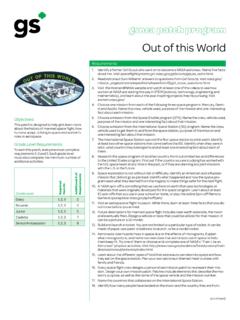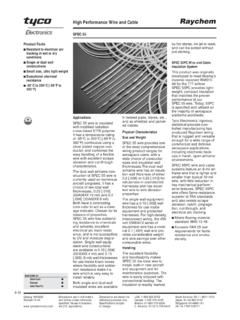Transcription of Bell Bags Environmental Impact Executive Summary
1 bell bags Environmental Impact Executive Summary All factors considered, NOAXE bell bags have superior Environmental benefits in comparison to alternatives paper bags , single use t-shirt bags , non-woven bags , and compostable bags . Greenhouse Gas (GhG) the emerging danger Greenhouse gases (CO2 and methane) trap heat in the atmosphere. [1] A large amount of GhG is emitted into the atmosphere from fossil fuels, and from trash decomposing in landfills. It has caused devastating outcomes like sea levels rising, global temperature rise, warming oceans, and shrinking ice sheets, all of which effect ecosystems and future generations. [2] [3]. Paper: Emissions from pulp and paper mills are the 4th largest industrial source of greenhouse gas in the United States.
2 [4]. Single use t-shirt bags : Emit fewer global warming gases, and produce substantially less acid rain emissions, and less solid wastes than traditional paper and compostable bags . [5]. Non-woven bags : Help lower GhG potential when used a minimum of 11 times compared to a traditional t-shirt bag that is not reused. [6]. Compostable bags : Contribute significant GhG when composted in industrial composting facilities or otherwise, generating GhG. [7] [8]. NOAXE: NOAXE bags significantly reduce GhG. Every time one is reused it eliminates the manufacture of a paper bag, or the high cost of recycling it. [9] [10]. Carbon Footprint Carbon footprints are defined as the total amount of GhG produced throughout the supply chain process that directly and indirectly supports human activities.
3 [11] It is usually expressed in the equivalent tons of carbon dioxide (CO2). Paper: Four times the energy is used to produce a paper bag than a single-use plastic bag. [12]. Seven times the fuel is used to ship to stores then reship them to the dump after only one use. Paper bags have an enormous carbon footprint. [13]. Single use t-shirt bags : Have a lower carbon footprint than reusable bags if the reusable bags are not reused at least 4 times. [14]. Non-woven bags : Emit times the GhG to manufacture than paper bags , more than twice the amount of energy to ship from Asia and reship in the US. [15] [16] Must be used 11 times to have an effective carbon footprint.
4 [17]. Compostables: Use about times more energy per pound to produce than single use t- shirt bags . Since they are 3-4 times heavier, they burn 8-11 times more energy. [18]. The Avantage Group, Inc. 250 No. Harbor Dr., Suite 311, Redondo Beach, CA 90277. (310) 379-3933, Fax (310) 376-0591, 1. NOAXE: For every one truckload of NOAXE bags , 4-5 truckloads are needed for the same number of handled paper bags . When reused 5, 10, 25 times, NOAXE bags save energy and gas, radically reducing it carbon footprint. [19] Do the math. [20]. Keeping bags out of landfills The Clean Air Act of 1979 promotes the reduction of GhG emitted in landfills, the 3rd most common source.
5 [21] Greenhouse gas emissions are caused by biodegradation of trash on or near the surface. It's important to understand, however, that in a properly engineered landfill, nothing is meant to degrade to avoid biodegradation and release of GhG. [22] Preventing degradation also prevents toxins from leaching into the water supply. [23]. Paper: Takes up as much as 50% of space in landfills. [24] A community of 50,000 citizens using only paper bags contributes 28 truckloads a year to the dump. [25] Ink from degrading paper bags is a known water contaminate. [26]. Single use t-shirt bags : Prevent premature release of GhG, but slowly degrade over 450.
6 Years, and most will be completely decomposed after 1000 years. [27]. Non-woven bags : Add more volume to a landfill than paper, unless reused at least twice, but take 450-1000 years to decompose! [28]. Compostables (D6400): Designed to decompose only in industrial composting facilities, of which there are few in the US. They add 50% more volume to landfills than paper. [29] [30]. NOAXE: One use takes up less in weight, or - less in volume than a regular or handled paper bags . Reuse it 10 times and save 92%-93% of paper ( fewer truckloads of trash in a community of 50,000!) [31]. Recyclability According to the EPA, recycling is the process of collecting and processing materials that would otherwise be thrown away as trash, and burning them into new products.
7 [32]. Paper: A pound of paper bags takes 91 times more energy to recycle than a pound of plastic bags . [33] The associated water pollution and air contamination is substantial. [34]. Single use t-shirt bags : Recycling thin plastic bags is difficult, and the return on the effort to recycle them is minimal. [35] The recycle rate may be as little as 5%. [36] [37]. Non-woven handle bags : According to EPA standards, they are not recyclable; there is no market for the material, no infrastructure in place to pick up and recycle them, and no cleaning and reprocessing facilities. Compostables: According to EPA standards, they are not recyclable; there is no market for the material, no infrastructure in place to pick up and recycle them, and no cleaning and reprocessing facilities.
8 The Avantage Group, Inc. 250 No. Harbor Dr., Suite 311, Redondo Beach, CA 90277. (310) 379-3933, Fax (310) 376-0591, 2. NOAXE: NOAXE bags may be recycled at most local supermarkets. It is far easier and more cost effective to recycle them compared to lightweight t-shirt bags . [38]. Toxicity, contamination, and pollution The toxicity of materials is based on how it affects humans, animals and plant life. The EPA's TRI. list (Toxic Release Inventory) is honored nationwide, with California adding its own DTSC list (Department of Toxic Substances Committee). [39] [40] Contamination and pollution is directly related to the release of toxic substances in the air, water, and earth.
9 Paper: Pulp and paper mills have been known to be one of the worst polluting industries worldwide, as seen at the Fox River in Wisconsin. [41] [42]. Single use t-shirt bags : Filthy and contaminated t-shirt bags shipped overseas to be recycled spread disease and are frequently sorted using unfair labor practices. [43] [44] [45]. Non-woven handle bags : May harbor harsh bacteria that could ultimately harm people. [46]. Massive ink used to print these bags is also a contaminant. [47]. Compostables: Contain toxic contaminants, GM corn (Genetically Modified) using GMOs (Genetically Modified Organisms) and are banned in over 60 countries. [48] [49] [50] [51].
10 NOAXE: The manufacturing process of NOAXE bags cuts air pollution by 55% over paper bags , with no water pollution. [52] Printing also requires 1/3 the ink of paper. [53]. Forests and wildlife NOAXE bags do no harm to forests and wildlife. Clear-cut forests are massive throughout North America just google a satellite map of Oregon, Washington or British Columbia. Don't be misled that forests regenerate themselves in only 30 years. In reality they take up to 150-500 years to regenerate. [54] According to the National Wildlife Federation, many forms of wildlife and endangered species live only in old growth forests. [55]. The Avantage Group, Inc.







